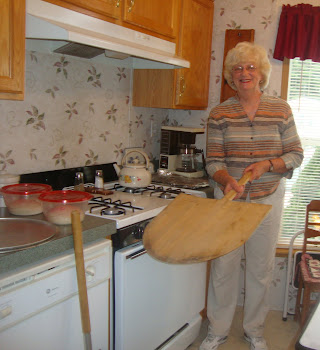I am trying another poolish milk kefir dough for Paul’s flour. The things I did different this time was changed the formula a little, used milk kefir in the poolish that was one week old, only put most of the formula water with poolish in, mixed in my Kitchen Aid Professional pro for 15 minutes on speed 5, then added the rest of the formula water with poolish and mixed at speed 5 for another 5 minutes. Now I am going to let the milk kefir dough autolyse for 20 minutes and then mix the salt and oil in the dough. This is the formula I am using and one picture after the dough was mixed, before the salt and oil were added.
I will post more pictures tomorrow of how the dough ball looks after adding salt and oil. I am going to try and let this finsihed dough ball sit out over night at my ambient room temperatures. This was done last evening.
This post is just to note what I did with the milk kefir poolish with Pauls’s flour, since last evening. I forgot to note in my last post that I mixed the milk kefir poolish with KASL, because I didn’t have enough of Paul’s flour to make the poolish and then the final dough. So now my flour and Paul’s flour are combined together.
After I took the picture last evening, I mixed the salt and oil in with the dough and had saved a little more of the milk kefir poolish to add at the end, after mixing the salt and oil into the dough. My mixer went on speed 5 again for 10 minutes to be able to mix the extra milk kefir poolish into the dough. I know this isn’t a traditional way to mix a dough, but I wanted to see what results this different technique will give in the final pizza, if any.
I did reball or stretch and fold this dough several times before oiling the dough ball. Each time the dough ball would become less sticky and would hold its shape for a little while and then relax. The dough ball was left out overnight at the ambient room temperature of 72 degrees F. The time for bulk fermentation was 8 hrs. The dough ball now is in the refrigerator until Tuesday.
When looking at member Warren’s (UnConundrum) Baguette - no knead - larger loaf, different times in the past at http://recipesonrails.com/recipes/show/436-baguette-no-knead-larger-loaf
, and watching the video Warren had posted at the end of that formula and directions to make the no knead Baguette, this was how I was able to make high hydration Sicilian pizzas in the past. Warren also posted a picture of his Sicilian pizza he made at Reply http://www.pizzamaking.com/forum/index.php/topic,9633.msg87635.html#msg87635
Where Warren has a formula for Focaccia - No Knead http://recipesonrails.com/recipes/show/518-focaccia-no-knead , he also was using a high hydration dough. I also wondered how his techniques would work with making a regular pizza with a higher hydration, something like I am doing with Paul’s flour or the recent Bagel dough I have been experimenting with. Although Warren mixed this dough for the no knead Baguette by hand and then did a number of stretch and folds and other things to his dough to make the dough more manageable, I think that these are some tricks to be able to work with high hydration doughs, when trying to make a pizza. I don’t know since my mix times are longer and my speeds on my mixer are higher, if this helps achieve a better dough or not. I will have to experiment with this more in future doughs.
Pictures below
Norma
This is a blog about my learning knowledge to make pizza. I have been helped by many people on my journey
Welcome...
There are so many variables that go into making a PIZZA. The hydration of the dough, flour, yeast and many more.. Amounts of any kind of yeast in a pizza can make a big difference. Most recipes posted on the web, use too much yeast in their recipes. What I have found out so far, is either bulk fermenting the dough or cold fermenting the dough will give a better flavor in the crust. I am still experimenting to find different flavors in the crust of pies. In my opinion pizza is all about the best flavor you can achieve in a crust. I still am on the journey about flavors in the crust. Even differences in temperatures in you home or times of the year can influence how much yeast to use. If you want a pizza to develop flavors in the crust, there are many ways to go about achieving this.
Adventure in Pizza Making
There are many ways to go about trying to make any kind of pizzas you want to create. PIZZA making is fun and also you get to eat your finished product. I learned to make all my pizza on http://www.pizzamaking.com/forum/index.php
If you look on pizzamaking.com you can see all the beautiful creations of pizzas members make on this site. Members and moderators help members and guests achieve almost any kind of pizzas they want to create. Since joining this site, my pizza making skills have gone from non-existent to something much better. I invite you to take a look at this site.
Total Pageviews
Subscribe to:
Post Comments (Atom)












No comments:
Post a Comment